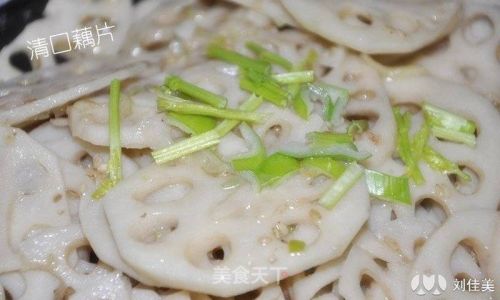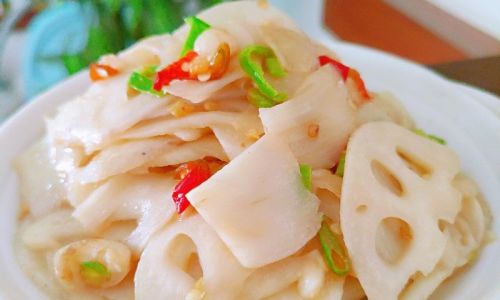Stir-fried lotus root slices, a beloved dish in many Asian cuisines, combine simplicity with exquisite flavor and texture. This humble vegetable, known for its crunchy consistency and subtle sweetness, transforms into a delightful meal when prepared with care. Whether you are a seasoned home cook or a novice in the kitchen, mastering this recipe will add a versatile and nutritious dish to your repertoire. In this comprehensive guide, we will explore the step-by-step process of creating stir-fried lotus root slices, from selecting the freshest ingredients to achieving that coveted balance of crispiness and tenderness.
The Allure of Lotus Root
Lotus root, or nelumbo nucifera, is a aquatic plant native to Asia, India, and parts of Australia. Its edible rhizome, characterized by a series of hollow chambers running through its length, has been cherished for centuries in traditional dishes and medicinal practices. Rich in dietary fiber, vitamins C and B6, potassium, and antioxidants, lotus root offers a range of health benefits, from aiding digestion to boosting immunity. Its unique texture—crisp when raw and tender yet slightly chewy when cooked—makes it a fascinating ingredient to work with.
Ingredients: Simplicity Meets Flavor
The beauty of stir-fried lotus root slices lies in its minimalist ingredient list, which allows the vegetable’s natural qualities to shine. Here’s what you’ll need:
- 400 grams fresh lotus root: Choose firm, unblemished roots with smooth, pale beige skin.
- 2 tablespoons cooking oil: Neutral oils like vegetable or peanut work best to avoid overpowering the dish.
- 3 garlic cloves, minced: For a fragrant aromatic base.
- 1-inch ginger, julienned: Adds a subtle warmth and depth.
- 1 red chili, deseeded and sliced (optional): For a hint of heat.
- 1 tablespoon soy sauce: Use light soy sauce for saltiness or dark soy sauce for color.
- 1 teaspoon rice vinegar: Balances the dish with a touch of acidity.
- 1/2 teaspoon sugar: Enhances the natural sweetness of the lotus root.
- 1/4 teaspoon white pepper: A pinch for aromatic complexity.
- 1 tablespoon cornstarch (mixed with 2 tablespoons water): For thickening the sauce.
- 1 tablespoon sesame oil (optional): For a nutty finish.
- 2 tablespoons chopped cilantro or spring onions: For garnish.
Preparation: The Foundation of Flavor
-
Cleaning and Slicing the Lotus Root:
- Rinse the lotus root under cool water to remove any dirt or debris.
- Using a sharp knife, trim the ends and peel the skin. The skin can be tough, so ensure it’s completely removed.
- Slice the root into thin, even rounds (about 1/8 inch thick). Uniformity is key to even cooking. For added visual appeal, make a few vertical cuts along the edges of each slice to create a floral pattern.
-
Soaking in Vinegar Water:

- Place the sliced lotus root in a bowl of cold water mixed with 1 tablespoon of vinegar. This step prevents oxidation (browning) and crisps the texture.
- Soak for 10–15 minutes, then drain and pat dry with a kitchen towel.
-
Preparing Aromatics and Sauce:
- Mince the garlic and julienne the ginger. If using chili, slice it diagonally for an elegant presentation.
- In a small bowl, whisk together the soy sauce, rice vinegar, sugar, white pepper, and cornstarch slurry. Set aside.
Cooking Process: A Symphony of Heat and Timing
-
Heating the Wok:
- Place a wok or large skillet over high heat. Allow it to smoke slightly—this ensures a searing hot surface for stir-frying.
- Add the cooking oil and swirl to coat the pan evenly.
-
Stir-Frying Aromatics:
Toss in the garlic, ginger, and chili (if using). Stir-fry for 15–20 seconds until fragrant but not browned. Overcooking aromatics can introduce bitterness.
-
Adding the Lotus Root:
- Drain the lotus root slices thoroughly (excess moisture will steam the dish instead of stir-frying it).
- Add the slices to the wok in a single layer. Allow them to sear undisturbed for 1 minute to develop a light golden hue.
- Toss gently with a spatula, ensuring each slice is coated in oil. Stir-fry for an additional 3–4 minutes until the lotus root turns translucent and slightly tender.
-
Incorporating the Sauce:

- Pour the prepared sauce over the lotus root. Stir vigorously to coat each slice. The cornstarch will thicken the sauce, creating a glossy finish.
- Cook for 1–2 minutes until the sauce clings to the vegetables. Avoid overcooking, as the lotus root should retain a slight crunch.
-
Finishing Touches:
- Drizzle with sesame oil (if using) for aromatic depth.
- Garnish with cilantro or spring onions. Serve immediately to preserve texture.
Tips for Perfection
-
Selecting Fresh Lotus Root:
Look for roots that feel heavy for their size, with no soft spots or wrinkles. Fresh lotus root should emit a mild, earthy scent.
-
Slicing Technique:
Use a mandoline slicer for ultra-thin, consistent slices. Thicker slices may require longer cooking times.
-
Controlling Heat:

Maintain high heat throughout stir-frying to achieve a charred, caramelized exterior without losing crispness.
-
Adjusting Seasonings:
Taste and adjust the sauce before adding it to the wok. For a sweeter profile, increase the sugar; for tanginess, add more vinegar.
-
Avoiding Overcrowding:
Cook the lotus root in batches if necessary. Overcrowding the pan leads to steaming, resulting in soggy slices.
Serving Suggestions
Stir-fried lotus root slices pair beautifully with a variety of dishes:

- Rice Bowls: Serve over steamed jasmine rice with a fried egg for a hearty meal.
- Noodle Stir-Fries: Toss with udon or soba noodles and vegetables for a colorful medley.
- Appetizer Platter: Arrange on a plate with dipping sauces like sweet chili or hoisin.
- Vegan Feasts: Combine with stir-fried mushrooms, bok choy, and tofu for a plant-based banquet.
Health Benefits and Nutritional Profile
Beyond its culinary appeal, lotus root is a nutritional powerhouse. A 100-gram serving provides:
- 73% of the RDI for vitamin C: Boosts collagen production and immunity.
- 12% of the RDI for potassium: Regulates blood pressure and fluid balance.
- 4 grams of dietary fiber: Aids digestion and promotes satiety.
- Antioxidants like flavonoids: Combats oxidative stress and inflammation.
Stir-frying preserves most of these nutrients, making the dish both delicious and wholesome.
Common Pitfalls and How to Avoid Them
-
Mushy Texture:
- Cause: Overcooking or insufficient draining before stir-frying.
- Fix: Monitor cooking time closely and ensure slices are dry.
-
Bland Flavor:
- Cause: Under-seasoning or skipping aromatics.
- Fix: Amplify the sauce with extra soy sauce or a pinch of salt.
-
Burnt Aromatics:
- Cause: High heat or prolonged cooking.
- Fix: Stir-fry aromatics briefly and remove from heat if needed.
Cultural Significance
In many Asian cultures, lotus root symbolizes purity, prosperity, and resilience—a nod to the plant’s ability to thrive in muddy waters. During festivals like Chinese New Year, it’s often included in feasts as a dish representing harmony and good fortune. Its hollow chambers also symbolize openness and clarity, making it a meaningful addition to celebratory meals.

Variations and Creative Twists
Experiment with flavors to suit your palate:
- Spicy Sichuan Style: Add Sichuan peppercorns and doubanjiang (fermented chili paste).
- Sweet and Savory Glaze: Replace soy sauce with honey and oyster sauce.
- Herb-Infused: Toss in fresh basil or mint leaves before serving.
- Crunchy Add-Ins: Mix in water chestnuts, bell peppers, or cashews for texture contrast.
Conclusion: Elevating the Everyday
Stir-fried lotus root slices are a testament to the magic of simple, fresh ingredients. With minimal effort, you can create a dish that delights the senses, nourishes the body, and connects you to centuries of culinary tradition. Whether served as a side dish or a standalone meal, its crisp texture and balanced flavors are sure to impress. So, the next time you spot a lotus root at the market, seize the opportunity to embark on a culinary adventure—one that transforms a humble vegetable into a masterpiece of crisp perfection.
Final Tip: Pair this dish with a crisp white wine or a fragrant green tea to enhance its delicate flavors. Bon appétit!





0 comments